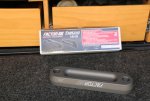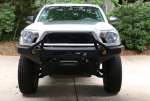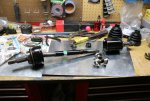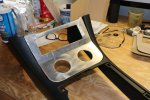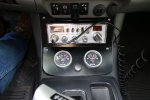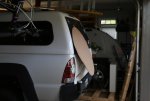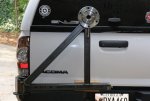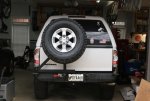Scott B.
SE Expedition Society
The last several weeks have allowed me time to get a lot of things done to the truck, both maintenance and mods. The scattered days of warm weather have helped, too.
First, a big maintenance project - u-joints and carrier bearing. While they might not be "worn out", I just passed 100,000 miles, so they are due for replacement.
Spicer parts

About to go back under...

Other maintenance items included a new serpentine belt and new spark plugs.
The first mod was seat spacers.
Reading all the commentary on seat spacers really got me wondering. Could tweaking the seat bottom angle really make that much of a difference?
To answer that question, I cut some 1" blocks out of a scrap 2x4, and placed them under the seat. No, I didn't drive this way - this was only a static test. Yes, moving the seat does make a difference.
However, being 6'2"+, I normally look out the upper 1/3 of the windshield. With the spacers in, my gaze out the windshield is even higher. But the seating is much more comfortable.
I sent a message to @olecoot, asking if he could cut me a set of 3/4" spacers. No problem - and they showed up the other day.

Using bolts that I already had on hand, the entire set installed in a few minutes.

I am anxious to take a long drive with them.
The next mod is a 5 for 1 deal. The base change is swapping the silver center dash trim piece for a black one. Purely cosmetic, but looks much better to me. I have always liked black interiors. Since the dash was coming apart anyway, I was able to do 4 other mods that each required the dash coming apart.
1. USB Charger
One of the 12V ports was replaced with a Blue Sea Fast Charge.

The lower dash, power ports removed:

The finished product

I had to open up the hole in the dash ever so slightly to fit the Fast Charge. For wiring, I made a short adapter from the factory wiring to the FC.
Why install the Fast Charge when I can just use a USB charger adapter? Simple - with my CB mounted under the dash, the adapter will not fit in the left-side port.
2. Seat Heater switches
As can be seen in the above pictures, I installed switches for seat heaters. I have the heater assemblies, and will install them once I figure out which way to upgrade the seats. Meantime, since the dash was apart...
3. TPMS Light Disable
After 3 1/2 years, my TPMS light is off!!!!!!!!
I cut the blue wire and tied it to the red w/white stripe. Works great!

4. Hypertech Speed Calibrator
After 3 1/2 years, my speedometer is much closer to my GPS reading!

This mod was purely plug and play. Program the box, plug it in. The hardest part was pulling the dash apart.

We're not done yet...
First, a big maintenance project - u-joints and carrier bearing. While they might not be "worn out", I just passed 100,000 miles, so they are due for replacement.
Spicer parts
About to go back under...
Other maintenance items included a new serpentine belt and new spark plugs.
The first mod was seat spacers.
Reading all the commentary on seat spacers really got me wondering. Could tweaking the seat bottom angle really make that much of a difference?
To answer that question, I cut some 1" blocks out of a scrap 2x4, and placed them under the seat. No, I didn't drive this way - this was only a static test. Yes, moving the seat does make a difference.
However, being 6'2"+, I normally look out the upper 1/3 of the windshield. With the spacers in, my gaze out the windshield is even higher. But the seating is much more comfortable.
I sent a message to @olecoot, asking if he could cut me a set of 3/4" spacers. No problem - and they showed up the other day.
Using bolts that I already had on hand, the entire set installed in a few minutes.
I am anxious to take a long drive with them.
The next mod is a 5 for 1 deal. The base change is swapping the silver center dash trim piece for a black one. Purely cosmetic, but looks much better to me. I have always liked black interiors. Since the dash was coming apart anyway, I was able to do 4 other mods that each required the dash coming apart.
1. USB Charger
One of the 12V ports was replaced with a Blue Sea Fast Charge.
The lower dash, power ports removed:
The finished product
I had to open up the hole in the dash ever so slightly to fit the Fast Charge. For wiring, I made a short adapter from the factory wiring to the FC.
Why install the Fast Charge when I can just use a USB charger adapter? Simple - with my CB mounted under the dash, the adapter will not fit in the left-side port.
2. Seat Heater switches
As can be seen in the above pictures, I installed switches for seat heaters. I have the heater assemblies, and will install them once I figure out which way to upgrade the seats. Meantime, since the dash was apart...
3. TPMS Light Disable
After 3 1/2 years, my TPMS light is off!!!!!!!!
I cut the blue wire and tied it to the red w/white stripe. Works great!
4. Hypertech Speed Calibrator
After 3 1/2 years, my speedometer is much closer to my GPS reading!
This mod was purely plug and play. Program the box, plug it in. The hardest part was pulling the dash apart.
We're not done yet...











